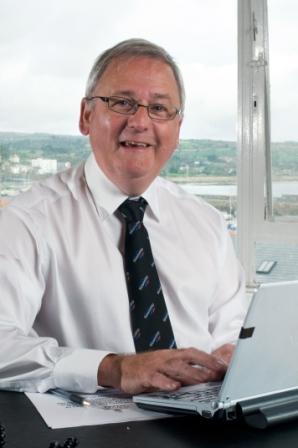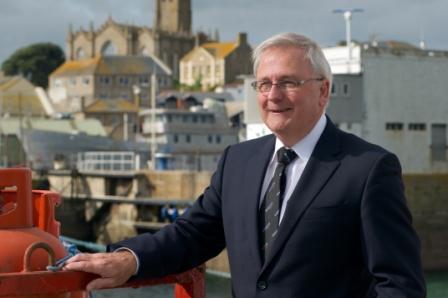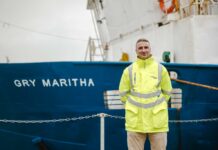
Face to Face with Jeff Marston, Chief executive of the Isles of Scilly Steamship company
Jeff Marston had originally intended on just helping out the Isles of Scilly Steamship Company board with some advice in a time of need, but he ended up staying on to become its chief executive.
That was eight years ago. Since then, Marston has helped turn the company into an extremely successful cash-rich business, with a turnover in the region of £10M.
The airline division, Skybus, has just celebrated its 25th anniversary with a record year, while the ferry and freight businesses continue to perform. And most recently, the Penzance-based company acquired the town’s old dry dock business.
Business Cornwall drops into the Isles of Scilly Steamship Company offices and finds Marston in a confident mood as he contemplates further growth for the famous old firm.
Business Cornwall: Can we start by running through the different company operations. It’s far more than just the Scillonian isn’t it?
Jeff Marston: We are primarily interested in getting people and freight to the Isles of Scilly, by sea and by air. By air we predominantly take people, although we also take some mail. By sea we take
people on the Scillonian III- and the majority of the people who visit the Isles still travel by sea – and we also have the Gry Maritha for freight. And at the end of August we added the Penzance dry dock to our portfolio. We have historically done marine engineering for our own purposes.
BC: So you’re now servicing other vessels as well?
JM: Yes, there’s a barge in there at the moment and when that goes out, the Gry Maritha will go in. So that’s an additional facility. There are peripheral areas of our business as well. We have the inter island launch service between St Marys and all the off islands, which is the freight vessel and also a small vessel which operates the mail contract. And we also operate Lands End Airport as our own airport, and it’s a fully equipped airport. It has an air traffic control unit, a rescue and fire service unit and a fully equipped engineering team to European standards. And we also have our own training school up there.
BC: How many aircraft do you have?
JM: We have three Twin Otters, three Britten Norman Islanders, and one Cesna 172 for the scenic flights. Twin Otters typically have 19 seats, but we tend to operate it in 16 or 17 seat mode, because we like to offer a little more legroom.
BC: The Twin Otter operates the route to St Brieuc in France. How’s that been going?
JM: We’ve been doing it for two years now. When we commenced, we started too early in the year. The season in France is really May through to September, which is different to our season on the Isles of Scilly. So we toned it down this year but it’s not an ideal time to operate a new route, to be honest.
BC: Because of the general economy?
JM: Yes, and I think there has been a lot of uncertainty this year about where people are going to holiday. There has been a lot in the press about ‘staycation’ but also people regretting maybe that they’ve stayed at home this year because the weather in August wasn’t as good as hoped. We’ll keep the route to France, but in essence next year it may change.
BC: Is it profitable?
JM: All new routes go through a period of time when the investment is high at the beginning and then settles down. Primarily our problem has been more to do with the airport in France. St Brieuc is twinned with an airport at Lannion, and they are encouraging us to think of going to Lannion, which we’re evaluating at the moment. It’s actually ten minutes more flying time. The funny thing about flying to France is we can’t fly straight. If we could, it would be a breeze, but we have to fly around the military no fly zone. Lannion is ten minutes longer in journey, but is actually shorter as the crow flies. But it has a good link to Paris, so it’s a good airport. We’re also currently evaluating resuming our service into the Guernsey area, and are in early discussions there.
BC: What routes do you operate at the moment?
JM: Southampton, Bristol, Exeter, Newquay and Lands End, and all to the Isles of Scilly. If you’re flying to the Isles of Scilly from the London area, then Southampton’s a great airport. Within four and a half hours of leaving your home in London, you can be in St Mary’s.
BC: And these are seasonal routes while Lands End is all year round?
JM: February to October. Lands End and Newquay are all year round, for local people and businesses.
BC: How have recent seasons been, bearing in mind the poor summers weatherwise?

JM: From a company point of view, Skybus has set record months this year. And that’s down to us as a company, we’ve been taking market share. And the way we’ve done that is by being reliable, offering high levels of customer service and pricing effectively. Skybus has had a really good year, and the ship has done well. The popular way is to fly out in the morning, and come back by ship. You get a longer day and it’s also a relaxed way of coming back. But while we’ve been enjoying a record year, I’ve got to say the overall market has been in decline slightly, which is not helped by the weather.
BC: So there is a clear integration between air and sea?
JM: Yes, and we also have an integration with our competitor, the helicopter service. We compete to win your patronage, but once we have won you, we undertake to get you there. It’s an island community in the Atlantic. Things like the weather can interfere, in many ways, and it’s not always appropriate to take people on the boat. So we move things around. Sometimes people will move from the airline to the sea, occasionally to the helicopter, quite frequently they go from the helicopter to the sea. We’ll get you there. And the thing with the airline and the ship is the price you pay is the price you pay, no hidden extras, no booking fees etc. And when we’ve got you, we honour that commitment to get you there and back. And for a small island community that’s important.
BC: British International Helicopters is the competition as you’ve said. How will its reported switch to Lands End work?
JM: We’ve in the past had discussions with them about Lands End. We’ve made it clear that the airport at Lands End is an airport, we’re happy for anyone to use it, within reason. They have, on the other hand, got to make their own decision what they want to do, and it wouldn’t be right for me to say what they want to do. We’re open to having discussions, but those discussions have gone quiet recently, which I suspect is because they have other issues going on in their company.
BC: I assume there will be planning hurdles to jump?
JM: Yes, and we’ve been quite open about it. I won’t decry our own facility, but it’s getting to the point where we need to invest in it, particularly the terminal building. We would also like to make some improvements to the site, we have some fencing issues in the area. We also want some temporary runway lights, not for 737s to land on, just something to aid the pilots when visibility isn’t as good as it could be. We’d trail them out in the morning and gather them up again in the evening.
These sort of things worry the local population, but we’ve dialogue with local groups and said ‘look, we’re an airport. You’re quite happy with us here as an airport, haven’t raised any objections and we’ve recently stopped flying Sundays, but we would like to improve our facility.’ And if someone like BIH wants to come along and use that, we’re going to accept them on a commercial basis. We already have a helicopter at Lands End. Trinity House have their maintenance base at Lands End and their helicopters fly from there regularly. So we’re not doing anything unusual, however it is up to BIH as to what they want to do as a business.
BC: Turning to Penzance Harbour and the proposed developments there. There are fears that the new ferry link might have to go to Falmouth if issues are not resolved.
JM: What I can say is we’ve been going through a process of competitive dialogue with Cornwall Council for some months about the route. But beyond that, I can’t say much more at the moment.
BC: But are you able to comment as to the importance of the ferry operating from Penzance?
JM: I am able to say quite clearly – the company was formed in 1920 and we’ve always operated from Penzance and I think you can make a judgement on that as to how we’d prefer to work.
BC: Because there are fears that if both BIH and the ferry leave Penzance, that many holidaymakers will bypass the town.
JM: I am sure those fears are well founded. I am sure the link we have from here provides a boost to the local economy. If nothing else, we employ quite a few people here.
BC: How many people do you employ?
JM: It varies a little bit, about 130 full time equivalents. And we employ highly skilled people. There aren’t that many passenger ferry operators in the area, so our maritime skills are high; we also employ 17 pilots. This is not what you normally find at the far end of Cornwall, highly paid, well skilled jobs. So we have an impact on the local economy and now that we have the dry dock, an even bigger impact on the local economy.
BC: Let’s talk about your background. How did you come to be chief exec of the Isles of Scilly Steamship company?
JM: I was regional managing director with a firm called ADT, one of the largest providers of fire and security systems in the world, when I came down here in 2001 to see the board because they had a problem, I was living in Cornwall at the time, and stayed! I was working in London and living in Cornwall, which isn’t ideal.
Prior to that I was with Compair, and my part of the business was relocated to the US, which was a kind way of saying I wasn’t working there much longer! Prior to Compair and ADT, I was MD of a firm making safety and survival equipment, such as life rafts and lifejackets on aircraft, and parachutes for the army and RAF. So I already knew all about the regulatory framework for the CAA (Civil Aviation Authority) and MCA (Marine and Coastguard Agency) and prior to that I spent my years making aviation bits and pieces. We are regulated heavily and that regulation adds real cost, but it’s there for safety. We have no issues about safety.
We’re 100% safety orientated. And one of things about building life rafts and parachutes is that you get the hang of it really early on. It has to work, because if it doesn’t you’ve killed someone!
BC: And you go out of business pretty quickly!
JM: Absolutely. So it’s that kind of experience that I was able to bring to the table. And we are flexible and multi-skill in a way that perhaps other companies don’t. On St Mary’s, we have people who were perhaps working on the quays or the boats, we just interchange them now so the job gets done, and we provide training so people can do that. It has overheads, but we’re not a fat organisation. Where we compensate is on multi-skilling and multitasking.
BC: How old is the Scillonian now?
JM: She entered service in 1977. But remember for the first ten years she operated all year round, but since then she has only operated for the season. So although she’s 32 years old, she is younger than that in terms of usage, and she was given a fairly major refit in 1999.
BC: Is she dry docked in the winter?
JM: No, she comes in to what we call the wet basin, and we give her some TLC. The crew stay on, strip down the engines if needed, refurbish the internals, and make sure she is spic and span for next season.
BC: How did taking the dry dock business come about?
JM: The dry dock was formed in 1834, a long established business. When we learned it was going into administration, there was not much of an outcry locally, which we were slightly concerned about because we saw there was a business there. So we looked at some of the issues and after discussions with the owners, made a proposal. And we’ve recruited some of the original staff.
BC: Does most work go to Falmouth?
JM: Some work goes to Falmouth, but Falmouth gets full. Also Falmouth is a big dry dock, and dry docks are expensive beasts, so for the size of some ships it’s inappropriate. When we wanted to dry dock our own ship early in the year, there was no space at Falmouth, so we would have had to gone to South Wales or round the coast. Shipping companies do that all the time, it’s no big deal, but for certain owners and certain types of vessel this is actually a good dry dock. And we are now marketing our services, which the previous owners probably didn’t do, to those customers.
BC: Where would most of the Newlyn boats go to?
JM: Fishing boats are slightly different. There was a slip at Newlyn, which they’ve replaced with a dry, but I think historically there has probably been a disconnect between Newlyn boats and the dry dock, and local personalities might have had a little bit to do with that. I think we will try and recover some of those vessels by talking to the owners. Also to the Council, about the sea fisheries vessel, the St Piran, which has historically gone elsewhere. We’ll be talking to local people, because we offer high levels of service and have a good reputation in the marine industry. We are going to make a very good effort to turn the dry dock into vibrating operating company.
BC: What else does the future hold do you think?
JM: We’ll continue to pushing to develop the airline, and may well do other things. Looking at the dry dock, I think part of me was probably testing the management team’s ability to expand the business. We’ll have a look at how that goes and make some decisions on what we could do. In the next two or three years we will be looking hard at where else we can take our skills. Because the Isles of Scilly Steamship Company
has been operating the route since the 1920s, it may give the impression that we haven’t made a lot of changes, but we are in fact making quite a lot of changes. We have a turnover just over £10M, we generate cash and have no debt. We also tend to own our assets. We’re a strong company and will get stronger.








